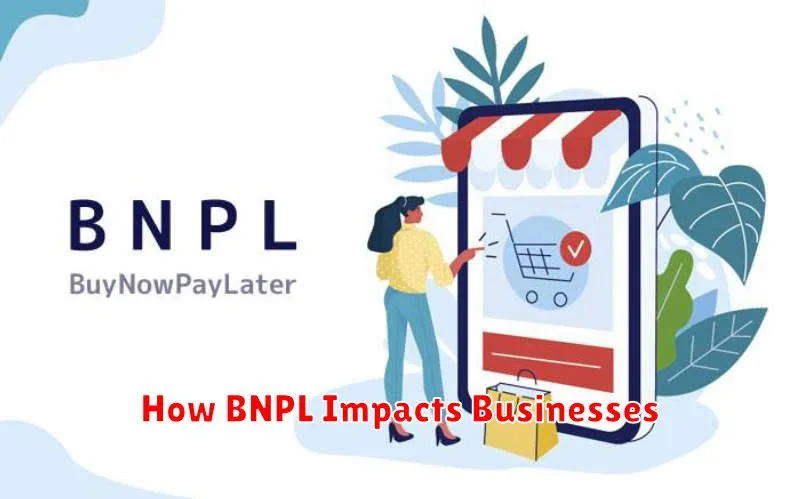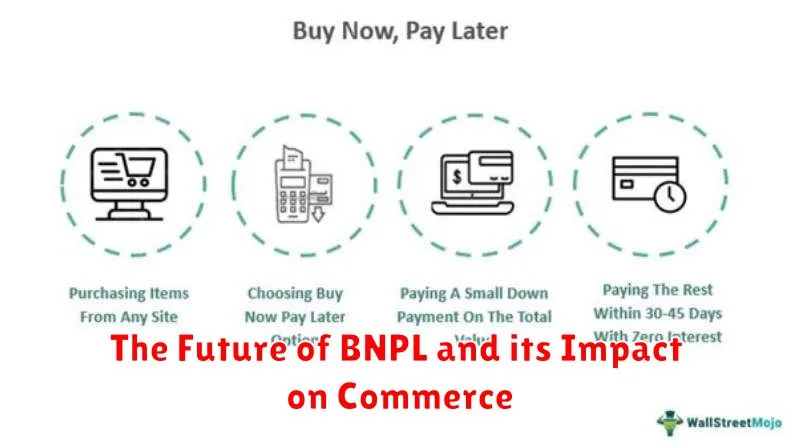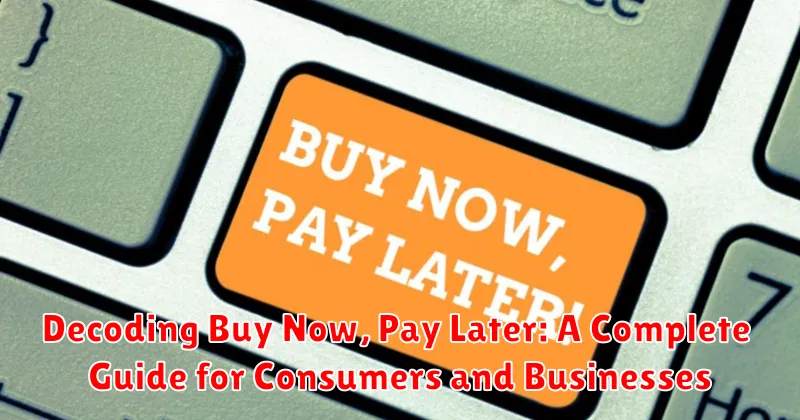Buy Now, Pay Later (BNPL) has rapidly transformed the landscape of consumer financing, offering a seemingly seamless way to purchase goods and services with deferred payments. This comprehensive guide delves into the intricacies of BNPL, providing consumers and businesses with the knowledge necessary to navigate this increasingly popular payment method. We will explore the benefits and drawbacks of BNPL, discuss its impact on credit scores, and analyze the regulatory landscape surrounding these short-term financing options. Understanding the mechanics, advantages, and potential pitfalls of BNPL is crucial for both consumers seeking flexible payment solutions and businesses looking to integrate this innovative financing model.
From interest-free installments to increased purchasing power, BNPL presents a range of advantages for consumers. However, the convenience of delayed payments can also lead to debt accumulation and financial strain if not managed responsibly. For businesses, adopting Buy Now, Pay Later can lead to higher conversion rates and increased average order values. This guide will examine the various BNPL platforms available, compare their fee structures, and provide practical tips for successful implementation and responsible utilization. Whether you are a consumer considering using BNPL for a future purchase or a business exploring its potential, this guide will equip you with the essential information to make informed decisions.
What is Buy Now, Pay Later (BNPL)?
Buy Now, Pay Later (BNPL) is a short-term financing option that allows consumers to make purchases and pay for them over time, often without incurring interest charges. It’s become an increasingly popular payment method at both online and brick-and-mortar retailers.
Essentially, BNPL services act as a point-of-sale loan, splitting the total purchase amount into smaller, more manageable installments. These installments are typically paid bi-weekly or monthly. Approval for BNPL services is usually quick and straightforward, often involving a soft credit check which has minimal impact on a consumer’s credit score.
BNPL is distinct from traditional credit cards. It often carries no interest if payments are made on time, and the repayment schedule is generally shorter and fixed. Unlike revolving credit lines offered by credit cards, BNPL agreements are tied to specific purchases. This makes it a potentially attractive option for budgeting and managing expenses related to a particular item.
How Does BNPL Work?
Buy Now, Pay Later (BNPL) services offer a short-term financing option at the point of sale. The process typically begins when a consumer selects BNPL as their payment method during checkout.
The BNPL provider conducts a soft credit check, which usually doesn’t impact the consumer’s credit score. Once approved, the consumer typically makes a small down payment, often 25% of the purchase price. The remaining balance is then divided into a series of interest-free installments.
These installments are usually paid bi-weekly or monthly over a predetermined period, often six weeks or less. Payment is automatically deducted from the consumer’s linked debit card, bank account, or credit card. If a payment is missed, late fees may be charged, and repeated late payments could negatively affect the consumer’s credit score.
Different BNPL providers may have slightly different terms and conditions, so it’s essential for consumers to understand the specifics of each service before using it.
Benefits of Using BNPL for Consumers
Buy Now, Pay Later services offer several advantages for consumers. Increased affordability is a key benefit, allowing shoppers to purchase items they might not otherwise be able to afford upfront. This can be particularly helpful for larger purchases like electronics or furniture.
BNPL options often provide budgeting flexibility by breaking down payments into smaller, manageable installments. This can make it easier to manage cash flow and avoid large, one-time expenses.
Convenience is another significant advantage. The application process is typically quick and easy, often integrated directly at checkout. This streamlined process can save time and effort compared to traditional financing options.
Some BNPL providers offer interest-free periods, allowing consumers to avoid interest charges if they pay off their balance within the specified timeframe. This can result in significant savings compared to using high-interest credit cards.
Risks and Considerations of Using BNPL
While BNPL offers appealing flexibility, consumers should carefully consider potential risks. Overspending is a major concern. The ease of splitting payments can lead to purchasing more than initially budgeted, accumulating debt quickly.
Hidden fees can also diminish the perceived benefit. Late payment fees, while often advertised as avoidable, can quickly accrue if not managed carefully. Some providers may also charge administrative or processing fees.
Impact on credit score is another important consideration. While some BNPL providers don’t report on-time payments to credit bureaus, missed or late payments can be reported, potentially negatively impacting your creditworthiness.
Finally, lack of regulation in some markets means fewer consumer protections compared to traditional credit products. It is crucial to understand the terms and conditions of each BNPL agreement before committing.
How BNPL Impacts Businesses

Buy Now, Pay Later services have a significant impact on businesses, both positive and negative. Integrating BNPL can lead to increased sales and average order values, as customers are more likely to purchase higher-priced items when offered flexible payment options.
Reduced cart abandonment is another potential benefit. Customers hesitant to commit to a large upfront payment may be more inclined to complete their purchase with a BNPL option. This can translate to higher conversion rates and overall revenue growth for businesses.
However, businesses must also consider the fees associated with BNPL services. These fees can cut into profit margins, and it’s crucial to factor them into pricing strategies. Furthermore, while BNPL providers typically handle customer payments and collections, businesses should still be aware of the potential for increased customer service inquiries related to payment plans and potential disputes.
Popular BNPL Providers
Several companies dominate the Buy Now, Pay Later (BNPL) landscape, each offering slightly different terms and features. Understanding these differences is crucial for both consumers and businesses.
Some of the most widely recognized BNPL providers include:
- Affirm: Often used for larger purchases, Affirm offers various payment plans, including interest-bearing options for longer durations.
- Afterpay: A popular choice for fashion and beauty purchases, Afterpay typically splits payments into four equal installments.
- Klarna: Provides a range of BNPL options, including pay-in-four, pay-in-30, and financing for larger purchases.
- PayPal Pay in 4: Integrated with PayPal, this service offers a simple four-payment installment plan for eligible purchases.
- Zip (formerly Quadpay): Similar to Afterpay, Zip divides purchases into four interest-free installments.
This list is not exhaustive, and new BNPL providers are emerging regularly. It’s important to research and compare different options before choosing a service that suits your needs.
BNPL Regulations and Consumer Protection
The regulatory landscape for Buy Now, Pay Later (BNPL) is still evolving. Currently, BNPL services often fall outside traditional credit regulations. This lack of oversight raises concerns regarding consumer protection, particularly around issues like fee disclosure, debt accumulation, and credit reporting.
Regulators are working to address these concerns. Some initiatives focus on increased transparency in fee structures and loan terms. Other proposals aim to bring BNPL services under the umbrella of existing consumer credit laws, affording consumers similar protections as traditional credit products. This could include mandatory credit checks and responsible lending practices.
Consumer advocacy groups play a vital role in advocating for stronger BNPL regulations. They often highlight the need for clear disclosures and responsible lending practices to protect vulnerable consumers from spiraling debt.
The Future of BNPL and its Impact on Commerce

The BNPL landscape is constantly evolving, driven by technological advancements and shifting consumer behavior. Increased integration with other financial technologies, such as digital wallets and budgeting apps, is likely. This could streamline the user experience and offer more personalized payment options.
Artificial intelligence and machine learning will play a larger role in credit assessment and fraud prevention, leading to more accurate risk evaluation and potentially wider access to BNPL services.
Furthermore, the expansion into new markets and demographics is anticipated. This includes targeting businesses for B2B transactions and offering BNPL options for higher-value purchases.
The future also holds the potential for greater regulatory scrutiny. As BNPL becomes more prevalent, governments and financial institutions are likely to implement stricter guidelines to protect consumers and ensure responsible lending practices. This could impact the ease and accessibility of BNPL offerings.

